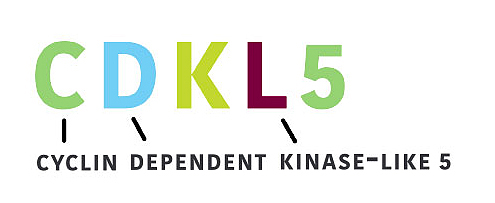What is CDKL5 Deficiency Disorder?

CDKL5 stands for “cyclin-dependent kinase-like 5”.
CDKL5 deficiency disorder is a rare developmental epileptic encephalopathy caused by mutations in the CDKL5 gene, and this can manifest in a broad range of clinical symptoms and severity. The hallmarks are early-onset, intractable epilepsy and neurodevelopmental delay impacting cognitive, motor, speech, and visual function. Although rare, the occurrence is believed to be ~1:40,000 -75,000 live births, making it one of the most common forms of genetic epilepsy.
The CDKL5 gene provides instructions for making proteins that are essential for normal brain and neuron development. The CDKL5 protein acts as a kinase, which is an enzyme that changes the activity of other proteins by adding oxygen and phosphate atoms (a phosphate group) at specific positions. Researchers have not yet determined which proteins are targeted by the CDKL5 protein.
CDKL5 was first identified in 2004, it stands for cyclin-dependent kinase-like 5, and its location is on the X chromosome. The X chromosome is one of the sex chromosomes; females have two X’s, and males have one X and one Y chromosome. The letters are an abbreviation of the scientific name of the gene, which describes what it does. The CDKL5 gene was previously called STK9. Many cases have been identified in boys, but because of the location of the gene, CDD mainly affects girls.
Symptoms of CDKL5 Deficiency Disorder - CDD
CDKL5 deficiency is associated with severe intellectual disability with complex health needs. A list of the most common symptoms can be seen below, however it is important to note there appears to be a wide spectrum in terms of the severity of some children, from moderately to profoundly affected.
• Epileptic seizures starting in the first 8 months of life (some exceptions have been reported)
• Infantile spasms (in about 50%)
• Many different seizure types including myoclonic jerks
• Very limited hand skills
• Hand stereotypies in the form of ringing movements or mouthing
• Marked developmental delay
• Limited or absent speech
• Hypersensitivity to touch, for example dislike of hair brushing
• Lack of eye contact or poor eye contact
• Cortical Visual Impairment (CVI), aka “cortical blindness”
• Characteristics such as a sideways glance, and habit of crossing legs
• Gastro‐esophageal reflux and other severe gastrointestinal issues such as low gut motility
• Constipation
• Small, cold feet
• Breathing irregularities such as hyperventilation
• Teeth Grinding
• Episodes of laughing or crying for no apparent reason
• Low/Poor muscle tone
• Some autistic‐like tendencies
• Scoliosis
• Apraxia
• Eating/drinking challenges (refusal to eat and drink, as well as giving up eating altogether)
• Interrupted sleep
